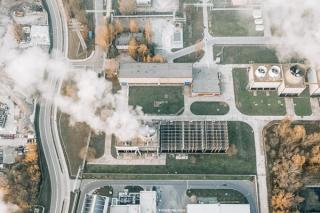
Why social impact must be accounted for like climate and nature
by Clodagh Connolly, Nicola Inge, Andres Schottlaender
View post

What is Occupied Buildings Risk Assessment?
Many major incidents in recent history (e.g. Flixborough, Hickson & Welch or BP Texas City) have resulted in fatalities to people within buildings. In such instances, explosions and/or thermal radiation have resulted in significant damage to, or prevented escape from, permanent and temporary site buildings.
An Occupied Buildings Risk Assessment (OBRA) is a type of process safety risk assessment that aims to determine whether buildings occupants are subject to unnecessary risk. What is defined as unnecessary is subjective, though it often comes down to whether the individuals of concern need to be close to a process or an operation. Where they don’t it might be reasonable to expect such occupants to be sited away from hazards or even treated as ‘off-site’ individuals (for which there are more stringent tolerability criteria), but if they don’t, greater levels of risk may be accepted with focus more towards emergency response and/or mitigation.
An OBRA specifically aims to address the potential for imposition of harm upon building occupants due to Major Accident Hazards (MAHs) and how they can affect emergency response. It is generally expected that the output of an OBRA is that the risks are ‘as low as reasonably practicable’ (ALARP) or, if not, what further action needs to be taken. They are typically carried out as standalone assessments but can often link into other hazard identification studies or risk assessments.
What are the lawful requirements for an OBRA?
There is no specific legal requirement to ‘conduct an OBRA’ though UK Regulators generally expect consideration of occupied building risk for all ‘MAH’ sites as a good practice contribution toward demonstration of ALARP principles under various regulations, particularly the Control of Major Accident Hazards (COMAH) Regulations 2015.
Upper-tier COMAH sites (i.e. those above a target threshold of hazardous materials held) are generally expected to estimate the level of individual risk posed to building occupants as part of their risk assessment under the Safety Report Assessment Manual (SRAM, Chapter 10). However, there is no specific requirement to perform a full OBRA and the term itself does not get specific mention in the Regulations or the supporting L111 documentation.
Lower-tier COMAH sites and non-COMAH sites may not be aware of any requirement to conduct an OBRA unless asked to do so by the UK Regulator. However, it is seen as industry good practice and retrospective action may be taken as a duty of care under the Health and Safety at Work etc. Act 1974 should an incident occur.
How to go about conducting an OBRA?
The key guidance in conducting such an assessment is detailed in the Chemical Industries Association (CIA) Guidance for the location and design of occupied buildings on chemical manufacturing and similar major hazard sites. The 4th edition of this guidance was published in 2020 with the assistance of HFL Consulting (now part of SLR).
An OBRA typically consists of a combination of qualitative and/or [semi-]quantitative risk assessment, depending on the level of rigour or focus required. The assessment typically involves an assessment of Major Accident Hazards (MAHs) against building locations to infer a level of risk, supplemented by a consideration of further risk reduction measures against a fundamental safety hierarchy. To conduct the assessment, an understanding of the buildings and their features, which may help or hinder emergency response, is key. The potential improvements necessary span relocating personnel; reducing the hazard at source; or increasing the protection offered by the building itself.
What are the OBRA-related challenges facing industry?
For upper-tier COMAH establishments, the requirement for OBRA is generally well understood but the assessments are often dependent upon the quality of the ‘predictive’ risk assessment that underpins the assessment of perceived risk from MAHs. For example, a focus on MAHs in an operational area of a site may omit scenarios that would otherwise dominate risk to occupied buildings and thus may not have been subjected to the same level of rigour in ALARP demonstration.
For lower-tier and non-COMAH establishments, OBRAs may not simply be present or understood, and can be an expensive commitment, particularly where in-house expertise is not present.
What should be your next steps?
All operators of MAH establishments should understand the need for and importance of an OBRA in the effective management of risk.
If an OBRA is already in place on an establishment, it should be reviewed regularly (e.g. every 5 years or following a significant change to site operations) and scrutinised for potential further improvements. Where an OBRA is not in place, regardless of COMAH status, an OBRA should be seen as a key risk assessment tool, even if conducted initially at a high-level to determine the need for a more detailed assessment.
Visit our Safety Advisory page to learn more about our services and how we can support you.
For a more detailed overview of OBRA, HFL Consulting (now part of SLR) are reopening registration to a one-hour webinar, recorded in June 2020 and available through our Virtual Learning Environment (VLE). We will also be running a one-day training course, with workshops via the CIA in the near future.